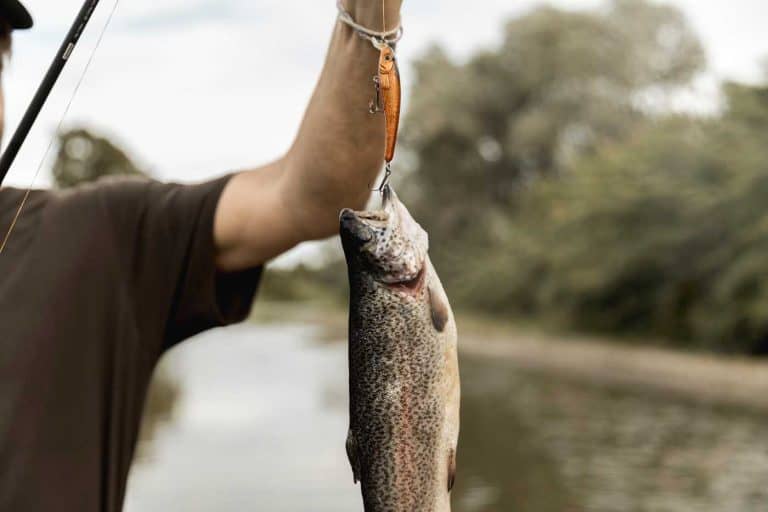Trout fishing is a cherished pursuit among anglers worldwide, offering a unique and exhilarating experience.
These resilient fish species, known for their vibrant colors and impressive fighting spirit, inhabit a diverse range of water bodies from crystal-clear mountain streams to deep, serene lakes.
The thrill of pursuing trout has captivated generations of fishermen, making it one of the most popular forms of recreational fishing.
As you plan your next trout fishing adventure, leveraging resources like the Fishbox App can provide invaluable insights into prime locations, water conditions, and peak times for trout activity.
This cutting-edge fishing forecast app equips you with a competitive edge, ensuring you maximize your time on the water and increase your chances of success.
Prime Locations for Trout Fishing
When it comes to finding the perfect trout fishing spot, anglers have a wealth of options to explore.
From rushing rivers and winding streams to tranquil lakes and ponds, trout thrive in a variety of water bodies, each offering its own unique challenges and rewards.
One of the most renowned regions for trout fishing is the majestic Rocky Mountains, where the Fishbox App can guide you to crystal-clear streams and rivers meandering through breathtaking landscapes.
The Appalachian Mountains in the eastern United States are also home to numerous trout-filled waterways, attracting anglers from far and wide.
It’s important to note that water quality and temperature play a crucial role in determining trout habitats.
Trout generally prefers cool, well-oxygenated waters, making pristine mountain streams and spring-fed lakes prime locations for successful trout fishing.
Areas with minimal pollution and healthy ecosystems are more likely to support thriving trout populations.
Strategies for Successful Trout Fishing
Tackle and Gear:
When it comes to trout fishing, having the right tackle and gear can make a significant difference in your success rate.
Light and ultra-light spinning rods paired with high-quality reels and monofilament or fluorocarbon lines are ideal for many trout fishing scenarios.
For fly fishing enthusiasts, a well-balanced fly rod, accompanied by a selection of flies mimicking the local insect hatches, can be a deadly combination.
Understanding Trout Behavior:
To consistently catch trout, it’s crucial to understand their behavior patterns and preferences.
Trout are opportunistic feeders, often keying in on aquatic insects, small baitfish, and crustaceans.
They tend to seek out areas with cover, such as submerged logs, undercut banks, or deep pools, where they can ambush prey while expending minimal energy.
By studying their feeding habits and preferred habitats, you can adapt your approach and increase your chances of success.
Presentation Techniques:
Successful trout fishing often hinges on your ability to present the bait or lure in a natural and enticing manner.
For spin fishing, techniques like drift fishing, live bait drifting, and slow, methodical retrieves can be highly effective.
Fly fishermen may employ various casting techniques, such as upstream or downstream presentations, to imitate the natural drift of aquatic insects.
Seasonal Considerations:
Trout fishing strategies can vary significantly depending on the season.
During the spring and fall, when water temperatures are mild, trout may be more active and aggressive, making topwater lures or dry flies a viable option.
In the heat of summer, they may seek cooler, deeper waters, requiring anglers to adjust their tactics accordingly.
Winter fishing can also be productive, with trout often congregating in deeper pools or areas with minimal current.
Patience and Persistence:
Trout fishing requires patience and persistence, as these elusive fish can be finicky and challenging to catch at times.
Don’t be discouraged by slow periods or missed strikes.
Instead, embrace the journey, appreciate the serene surroundings, and stay focused on your presentations.
With time and experience, you’ll develop a keen understanding of trout behavior and the techniques that consistently produce results.
Safety Tips
While trout fishing can be an exhilarating and rewarding pursuit, it’s essential to prioritize safety at all times.
Wear appropriate clothing and footwear to ensure stability and traction on slippery surfaces.
Exercise caution when wading in deep or fast-moving waters, and consider using a wading staff for added support.
Be mindful of potential hazards, such as submerged rocks or overhanging branches, and always keep a watchful eye on changing weather conditions.
Conclusion
Trout fishing is a captivating sport that offers a unique connection to nature and a chance to challenge one’s angling skills.
By exploring prime locations, understanding trout behavior, and employing effective strategies, anglers can increase their chances of success and create lasting memories on the water.
Remember, patience, persistence, and a willingness to adapt to changing conditions are key ingredients for a successful trout fishing adventure.
Embrace the journey, respect the environment, and savor the thrill of pursuing these remarkable fish, and don’t forget to use a fishing forecast app to help you through your journey.
With the right mindset and a commitment to continuous learning, you’ll be well on your way to becoming a skilled and accomplished trout angler.
